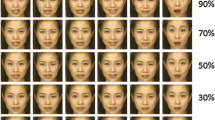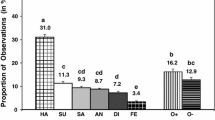Abstract
The performance of children at ages 4, 6, and 8 years was compared on the four types of task most often used in facial expression studies with children. We examined whether the order of mastery of emotions at different ages was constant across tasks, or alternatively, if it was task-specific. The relative difficulty of the tasks was also investigated, with the aim of arranging them into a hierarchy of increasing difficulty. The four tasks used were situation discrimination, matching discrimination, forced choice labeling, and free labeling. Accuracy was found to increase with age, but the interaction between age, type of task, and emotion was not significant. These results suggest that conclusions about the ordering of specific emotions from least to most difficult at different ages is not task dependent. Nevertheless, a significant interaction found between task and emotion suggests that such conclusions should specify which type of task generated the pattern. A hierarchy of difficulty for the tasks was only partially supported. Performance on the first three tasks was very similar but performance on free labeling was significantly poorer.
Similar content being viewed by others
References
Adams, K., & Markham, R. (1991). Recognition of affective facial expressions by retarded and nonretarded children and adolescents.American Journal on Mental Retardation, 96 21–28.
Bullock, M., & Russell, J. (1985). Further evidence on preschoolers' interpretation of facial expressions.International Journal of Behavioral Development, 8 15–38.
Camras, L. (1980). Children's understanding of facial expressions used during conflict encounters.Child Development, 1 879–885.
Camras, L., & Allison, K. (1985). Children's understanding of emotional facial expressions and verbal labels.Journal of Nonverbal Behavior, 9 84–94.
Ekman, P., & Friesen, W. (1975).Unmasking the face. Englewood Cliffs, NJ: Prentice-Hall.
Ekman, P. (1976).Pictures of facial affect. Palo Alto, CA: Consulting Psychologists Press.
Ekman, P. (Ed.). (1982).Emotion in the human face. New York: Cambridge University Press.
Felleman, E., Barden, R., Carlson, C., Rosenberg, L., & Masters, J. (1983). Children's and adult's recognition of spontaneous and posed emotional expressions in young children.Developmental Psychology, 19 405–413.
Field, T., & Walden, T. (1982). Production and discrimination of facial expressions by preschool children.Child Development, 53 1299–1311.
Fraser, C., Bellugi, U., & Brown, R. (1963). Control of grammar in imitation, comprehension, and production.Journal of Verbal Learning and Verbal Behavior, 2 121–135.
Frijda, N. (1986). Facial expression. In H. Ellis, M. Jeeves, F. Newcombe, & A. Young (Eds.),Aspects of face processing (pp. 319–325). Dordrecht: Martinus Nykoff.
Gates, G. (1923). An experimental study of the growth of social perception.Journal of Educational Psychology, 14 449–461.
Green, J., & Ekman, P. (1973). Age and the recognition of facial expression of emotion. Unpublished manuscript cited in Camras, L., & Allison, K. (1985). Children's understanding of emotional facial expressions and verbal labels.Journal of Nonverbal Behavior, 9 84–94.
Harrigan, J. (1984). The effects of task order on children's identification of facial expressions.Motivation and Emotion, 8 157–169.
Iacobbo, M. (1978). Recognition of affective facial expressions by retarded and nonretarded individuals across the life span.Dissertation Abstracts International, 38, 3995B.
Iannotti, R. (1978). Effect of role-taking experiences on role-taking, empathy, altruism, and aggression.Developmental Psychology, 14 119–124.
Izard, C. (1971).The face of emotion. New York: Appleton-Century-Crofts.
Kirouac, G., Doré, F., & Gosselin, P. (1985). Accuracy of judgment of facial expressions of emotions as a function of sex and level of education.Journal of Nonverbal Behavior, 9 3–7.
Michalson, L., & Lewis, M. (1985). What do children know about emotions and when do they know it? In M. Lewis & C. Saarni (Eds.),The socialization of emotions (pp. 117–139). New York: Plenum.
Odom, R., & Lemond, C. (1972). Developmental differences in the perception and production of facial expressions.Child Development, 43 359–369.
Oster, H., Daily, L., & Goldenthal, P. (1989). Processing facial affect. In A. Young & H. Ellis (Eds.),Handbook of research on face processing (pp. 107–161). Amsterdam: Elsevier Science Publishers B.V. (North-Holland).
Pitcairn, T. (1989). Origins and processing of facial expressions. In A. Young & H. Ellis (Eds.)Handbook of research on face processing (pp. 107–161). Amsterdam: Elsevier Science Publishers B.V. (North-Holland).
Reichenbach, L., & Masters, J. (1983). Children's use of expressive and contextual cues in judgments of emotion.Child Development, 54 993–1004.
Russell, J., & Bullock, M. (1986). On the dimensions preschoolers use to interpret facial expressions of emotion.Developmental Psychology, 22 96–102.
Salzen, E. (1989). The construction of emotion from facial expression. In A. Young & H. Ellis (Eds.),Handbook of research on face processing (pp. 177–186). Amsterdam: Elsevier Science Publishers B.V. (North-Holland).
Smiley, P., & Huttenlocher, J. (1989). Young children's acquisition of emotion concepts. In C. Saarni & P. Harris (Eds.),Children's understanding of emotion (pp. 27–49). Cambridge, UK: Cambridge University Press.
Sogon, S., & Izard, C. (1985). Ability to recognize emotion in normal and mentally retarded Japanese children.Japanese Psychological Research, 27 125–132.
Tremblay, C., Kirouac, G., & Doré, F. (1987).The Journal of Psychology, 121 341–350.
Wagner, H., MacDonald, C., & Manstead, A. (1986). Communication of individual emotions by spontaneous facial expressions.Journal of Personality and Social Psychology, 50 737–743.
Walden, T., & Field, T. (1982). Discrimination of facial expressions by preschool children.Child Development, 53 1312–1319.
Wiggers, M., & van Lieshout, C. (1985). Development of recognition of emotions: Children's reliance on situational and facial expressive cues.Developmental Psychology, 21 338–349.
Author information
Authors and Affiliations
Rights and permissions
About this article
Cite this article
Markham, R., Adams, K. The effect of type of task on children's identification of facial expressions. J Nonverbal Behav 16, 21–39 (1992). https://doi.org/10.1007/BF00986877
Issue Date:
DOI: https://doi.org/10.1007/BF00986877




